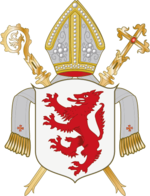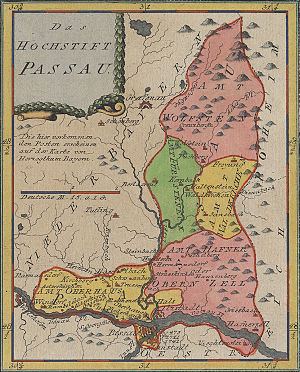Passau bishopric
The bishopric of Passau was the secular domain of the prince-bishops of Passau and existed until secularization by the Reichsdeputationshauptschluss on February 22, 1803. While the Diocese of Passau with 42,000 km² was the largest diocese of the Holy Roman Empire and temporarily extended over Vienna to the west of Hungary expanded, the Hochstift Passau was much smaller at last 991 km². It was around the city of Passau mainly in the region of the Bavarian Forest .
|
Territory in the Holy Roman Empire |
|
|---|---|
| Passau bishopric | |
| coat of arms | |

|
|
| map | |

|
|
| Alternative names | Principality , bishopric , pen |
| Form of rule | Electoral principality / corporate state |
| Ruler / government | Prince-bishop , administrator or vacant : cathedral chapter |
| Today's region / s | DE-BY , AT-4 |
| Parliament | 1 virile vote on the ecclesiastical bench in the Reichsfürstenrat |
| Reichskreis | Bavarian |
| Capitals / residences | Passau |
| Denomination / Religions | Roman Catholic |
| Language / n |
German , Latin
|
| Incorporated into | western part to Bavaria, eastern part to the Electorate of Salzburg
|

history
Diocese
The diocese of Passau was founded in 739 by Boniface .
However, various documents and letters from the 10th century ( Lorcher forgeries ) should prove that it emerged from the ancient bishopric of Lauriacum . Bishop Vivilo is said to have moved his seat to Passau when the Avars destroyed Lorch . This was intended to establish a historical privilege over the Archdiocese of Salzburg in the 13th century and the right to its own archdiocese.
Beginnings of the Hochstift
999 was by the then Emperor Otto III. the judicial and administrative sovereignty, the market, coin and customs rights over the city of Passau were transferred to Bishop Christian von Passau . This was the first time that the bishop was the political head of the city. In the investiture dispute in 1078 he temporarily had to surrender these rights to the burgrave Ulrich von Passau appointed by King Heinrich IV , but only for a short time. As early as 1099, the emperor returned the rights to the bishopric.
In 1161, Emperor Friedrich I donated the monastery Niedernburg, which was directly part of the empire, with its possessions and privileges to the cathedral monastery . However, the extensive area was interspersed with the county in Ilzgau (comitia in Ylskeu), which was granted by the empire, as well as bailiffs and fiefdoms. In 1207 the county was acquired. Large parts of the County of Windberg also came to the Hochstift from the Duke of Meran . In 1217, Emperor Friedrich II confirmed the land of the abbey ( Abteiland ) north of Passau to the bishopric . In 1227 the rule of Viechtenstein was purchased .
Bishop Otto von Lonsdorf dissolved the bishopric from the umbrella bailiwick of the Bavarian dukes in 1262 and thus acquired imperial immediacy .
Bavarian and Austrian claims
The considerable prosperity of the bishopric repeatedly aroused covetousness among its neighbors Bavaria and Austria in the following centuries . In 1248, the Bavarian Duke Otto II gained control of the St. Nikola Monastery and the associated Hofmark. From then on, St. Nikola belonged to Bavaria and was outside the Passau bishopric. In 1289 Duke Albrecht I of Austria seized the rule of Falkenstein and thus moved the border of the bishopric to Austria to the west.
In 1387 there were open disputes between three applicants for the office of bishop, namely the cathedral dean Hermann, Ruprecht von Berg and Georg von Hohenlohe , until after three years Georg got the upper hand. The learned Leonhard von Laiming (1424–51) beautified the city, the residence and the castles that dominated Passau after the conflagrations of 1435 and 1437. Under his successor Ulrich von Nussdorf , persecution of Jews took place in Passau in 1478.
The rule of Rannariedl was sold on November 15, 1487 by Bishop Friedrich Graf von Öttingen to Duke Georg the Rich . Through the Landshut War of Succession in 1504/1505, this rule fell to Maximilian I and thus to Austria.
The western part of the rule, the " Seven Künischen Villages " Wollaberg , Heindlschlag , Hintereben , Jandelsbrunn , Rosenberg , Aßberg and Grund as well as the court Wildenranna , now formed a large Austrian enclave in the high estates area. The county of Hals , which fell to the Wittelsbach family in 1517 , formed a Bavarian enclave , while on the other hand Aigen am Inn was a highly esteemed exclave in Bavarian territory.
Consolidation of the highly penal area
For a long time, the Passau bishopric was far removed from a modern territorial state, because there was no unified manorial rule or jurisdiction, but rather several simultaneously effective authorities with different property rights and privileges.
In 1552 the Passau Treaty was signed , which paved the way for the toleration of denominations in the Augsburg religious peace. In 1592, Bishop Urban von Trennbach acquired the lordships of Buchberg, Wildenstein and Röhrnbach . Various goods belonging to the Saldenburg rulership were also purchased at this time. Urban von Trennbach drove all Protestants out of Passau and participated in the Counter-Reformation of Rudolf II in Austria. Two archdukes of Austria were among the more important Passau prince-bishops of this time: Leopold and Leopold Wilhelm . The former founded the villages of Leopoldsreut , Herzogsreut and Schwendreut in 1618.
In 1662 a fire reduced the city of Passau to rubble and during the reconstruction, the city developed its current Mediterranean-style baroque appearance. Bishop Cardinal Johann Philipp von Lamberg acquired the last secular court brands Empertsreut and Wartberg near Perlesreut and Großwiesen and Kaltenstein near Röhrnbach. He founded the villages of Philippsreut (1692), Mauth (1698), Zwölfhäuser (1699), Vierhäuser (1699), Hohenröhren (1700), Heinrichsbrunn (1703), Finsterau (1704) and Bischofsreut (1705) in the border area with Bohemia .
1691 / 1692 there was a demarcation to Bavaria with landmarks between Lusen and chaplain stone in Ringelai . The demarcation of the impassable forest area in the north-east and Bohemia was also controversial for centuries. Only between 1752 and 1772 could a linear national border be established.
Bishop Joseph Dominikus von Lamberg acquired the County of Neuburg in 1730 for 515,000 guilders and 1,000 ducats. He founded the villages of Raimundsreut (1721), Annathal (1724) and Frauenberg (1724).
In 1765, Bishop Leopold Ernst von Firmian bought back the seven Künischen villages and Wildenranna from Austria for 137,787 guilders. In the same year the Passau court chamber decreed that the area of the bishopric could no longer be called the “Land of the Abbey”, but in future only “Principality of Passau”.
When the Innviertel became part of Austria after the Treaty of Teschen in 1779, on June 27, 1782, Bishop Leopold Ernst Graf von Firmian ceded the area to the right of the Danube around Viechtenstein and the dominion of Obernberg- Riedenburg to the right of the Inn . Its founding in the border area to Bohemia are the localities Vorder- , Mitter- and Hinterfirmiansreut (all 1764).
The last episcopal town to be founded on the Bohemian border was Auersbergsreut by Prince-Bishop Joseph Franz Anton von Auersperg in 1786.
Dissolution of the Hochstift
The Passau bishopric was secularized under Prince-Bishop Leopold Leonhard Raymund von Thun on February 22, 1803 through the Reichsdeputationshauptschluss . The city and the fortress with the western part of the bishopric came to Bavaria, the larger eastern part first came into the possession of the previous Grand Duke of Tuscany Ferdinand , who was now elector of Salzburg , and after the Peace of Pressburg in 1806 also to Bavaria . During the secularization, the area of the bishopric covered 991 km² with over 52,000 inhabitants.
The last Passau prince-bishop von Thun could not come to terms with these changes and lived on his property in Cibulka near Prague until his death in 1826.
literature
- Ludwig Veit : Passau. The Hochstift , Historical Atlas of Bavaria , Part of Old Bavaria, Series I, Issue 35, Munich 1978, ISBN 3-7696-9896-7 ( digitized version ).
- Paul Praxl : The history of the Wolfsteiner Land . In: The Freyung-Grafenau district . Verlag Landkreis Freyung-Grafenau, Freyung 1982, ISBN 3-87553-192-2 .
- August Leidl : Little Passau diocese history . Passau 1989.
- Franz Mader : The Diocese of Passau yesterday and today . Editor of the Episcopal Ordinariate Passau, Passau 1989.
- Edith Ringelmann: The secularization of the bishopric and the cathedral chapter of Passau . Passau 1939 (= publications of the Institute for East Bavarian Homeland Research in Passau. Volume 18).